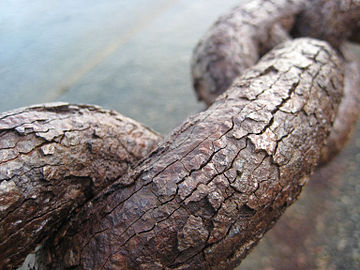Did you know?
You can double click on a word to look it up on TermGallery.
You can double click on a word to look it up on TermGallery.
Meanings of redox in anglès
rus
восстановители portuguès
reacções de oxirredução català
reacció d'oxidació-reducció espanyol
reacción redox 
Chemical reaction involving reduction and oxidation of different species.
Synonyms
Examples for "oxidoreduction"
Examples for "oxidoreduction"
1
Functional categorization of the 55 induced genes revealed that most were either related to carbon metabolism, membrane proteins, or were involved in oxidoreduction reactions.
1
Their versatility, which arises from an ability to undergo reduction-oxidation chemistry, enables them to act as critical cofactors of enzymes throughout the cell.
2
Reactive oxygen species, generated by reduction-oxidation (redox) reactions, have been recognized as one of the major mediators of ischemia and reperfusion injury in the brain.
3
Reduction-oxidation (redox) signaling systems are emerging as important targets in pancreatic cancer.
1
Iron-sulfur clusters are prosthetic groups commonly found in proteins that participate in oxidation-reduction reactions and catalysis.
2
The N-terminus of MTRR containing a conserved domain of FMNRed is closely concerned with the oxidation-reduction process.
3
The mutated proteins show spectral properties similar to those of the wild-type enzyme, in all oxidation-reduction states.
4
This is in accord with the high oxidation-reduction potential of the flavin, which thermodynamically stabilizes the reduced enzyme.
5
In comparison, 27 proteins were up-regulated in dark-cutting beef related to oxidation-reduction processes, muscle contraction, and oxidative phosphorylation.
1
This cyclic redox reaction of the metal generates OH.
2
Taken together these data demonstrate that H296 is responsible for proton exchange in the redox reaction.
3
Flavin-based electron-bifurcation is a mechanism that couples an exergonic redox reaction to an endergonic one allowing energy conservation in anaerobic microorganisms.
4
This provides mass spectrometric evidence for the mechanism of the nitro to amine conversion process during nitroreduction, an important redox reaction involved in carcinogenesis.
5
Re-evaluating these previous data we here discuss a mechanism, by which the redox reaction of N2 induces conformational changes possibly leading to proton translocation.
Usage of redox in anglès
1
However, the identity of most redox-regulated mitochondrial proteins remains to be defined.
2
This process obviates the need for exogenous enzymes and redox mediator supplements.
3
These findings reveal a new layer of nitroso-redox imbalance in dystrophic cardiomyopathy.
4
These single-domain flavoenzymes display redox potentials compatible with electron transfer between partners.
5
Hence, there is interest in redox and metabolic modulators as anticancer agents.
6
In addition, the redox properties of the Te functionalities have been explored.
7
Blood free radical concentration was reduced, that is, CV improved redox homeostasis.
8
Manipulation of redox signaling may be beneficial in cancer patients receiving trastuzumab.
9
Solution and solid state CV studies revealed the redox-active characteristics of the complexes.
10
The redox balance in the renal cell seems, therefore, of the utmost importance.
11
CSK therefore provides a redox regulatory mechanism that couples photosynthesis to gene expression.
12
These markers play important roles in redox regulations throughout the body.
13
Importantly, disruption of redox organization is a common basis for disease.
14
The redox-sensitive transcription factors AP-1 and NF-kappaB have been implicated in these effects.
15
These results define a novel redox-based mechanism to propagate Fas-dependent apoptosis.
16
This redox cycle may constitute the principal physiologic function of bilirubin.
About this term
Frequent collocations
More collocations
Translations for redox
rus
portuguès
Redox through the time
Redox across language varieties

United States of America
Common

